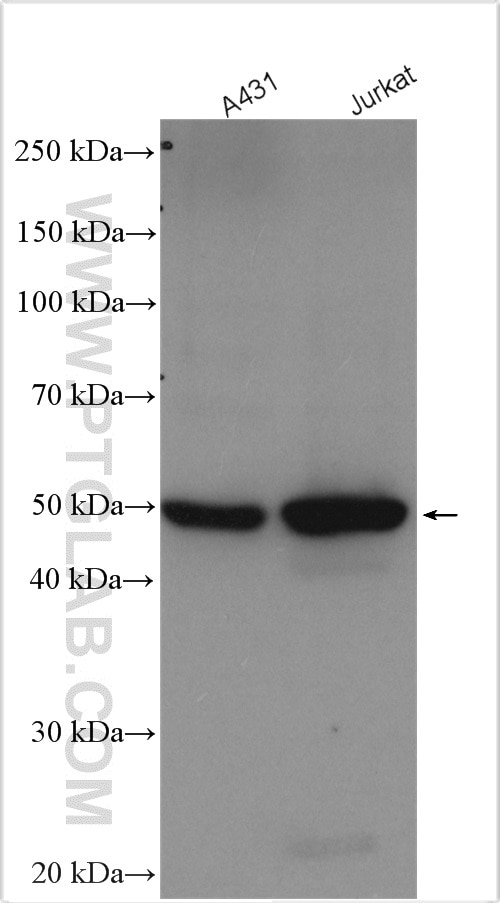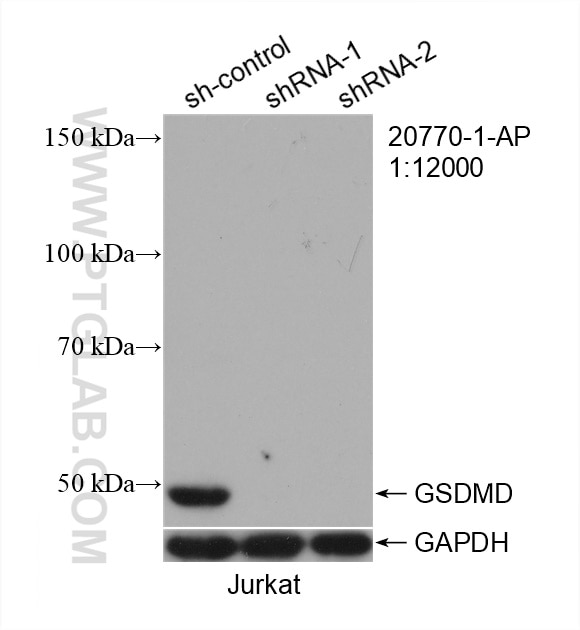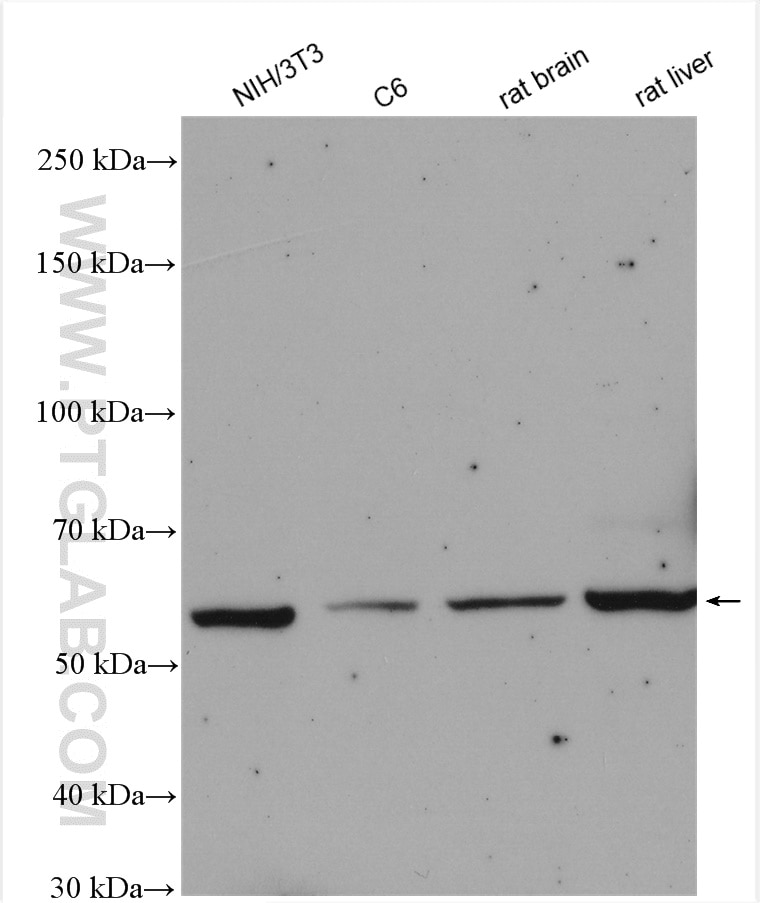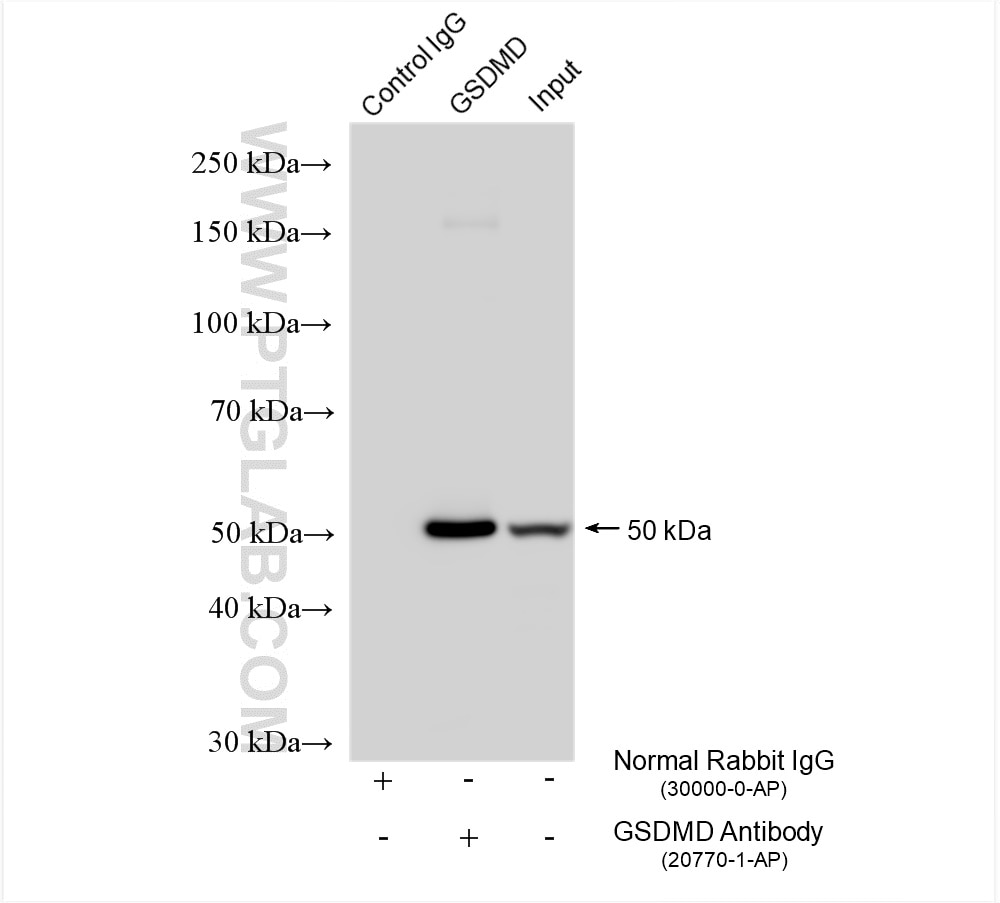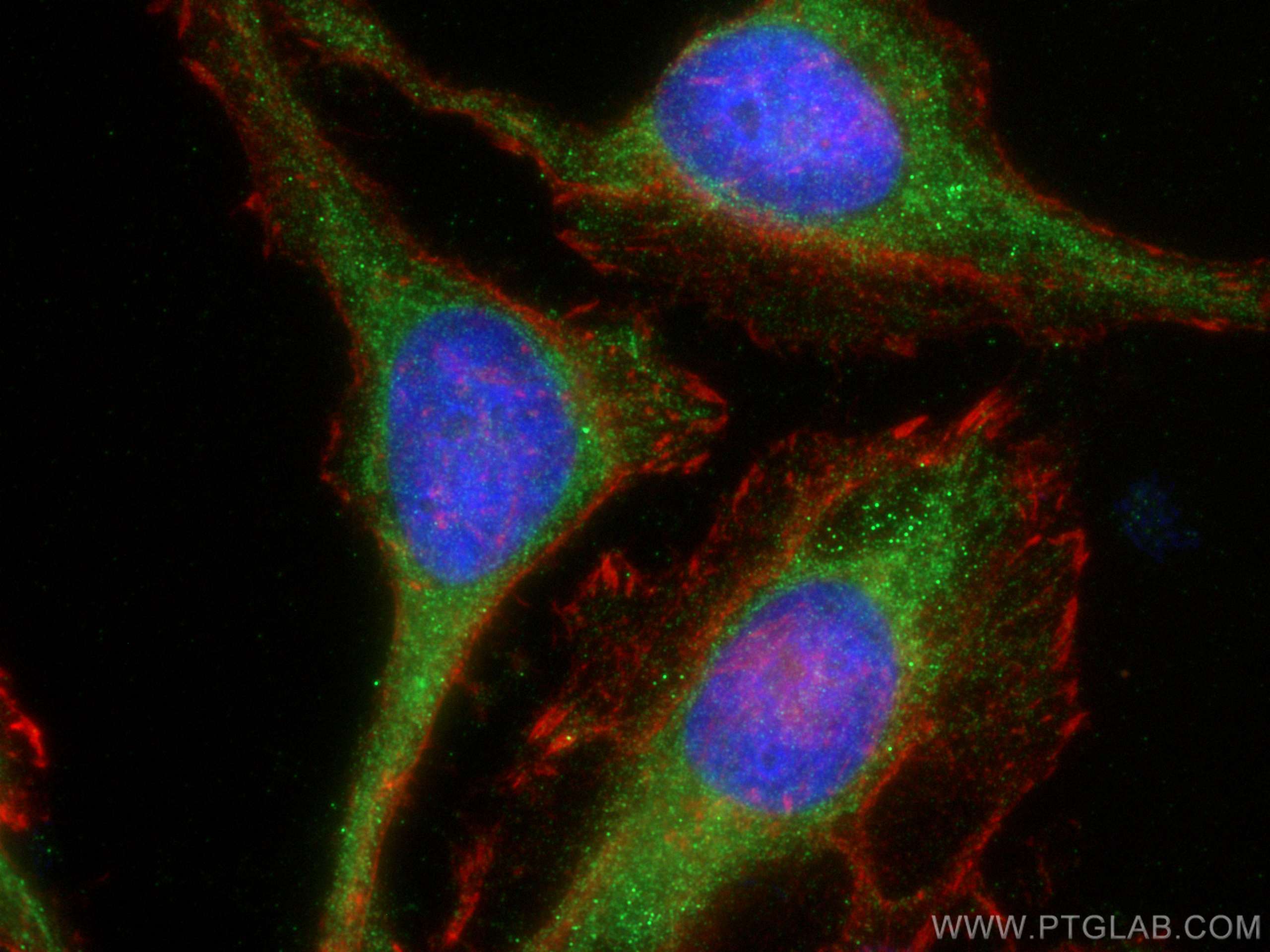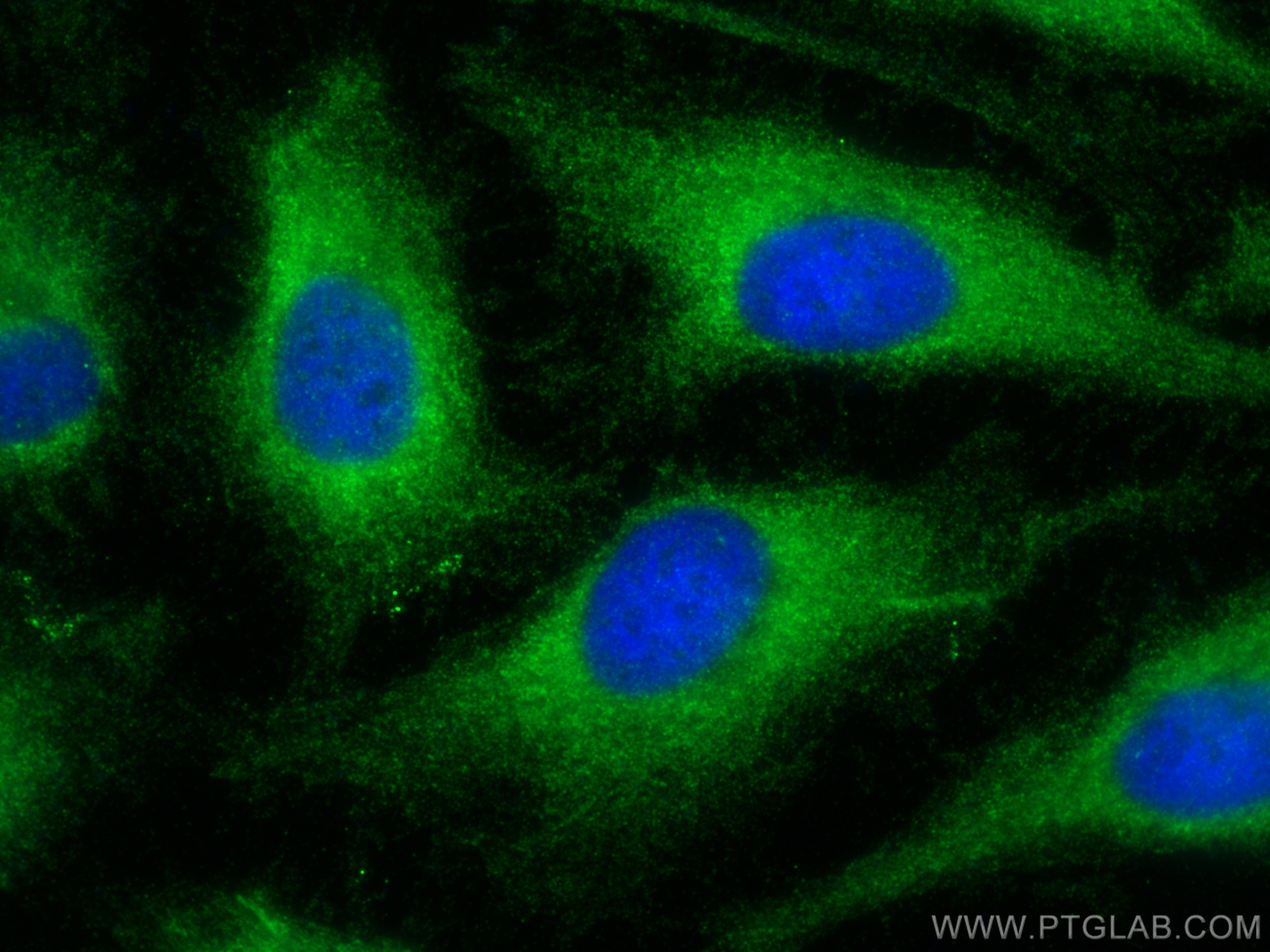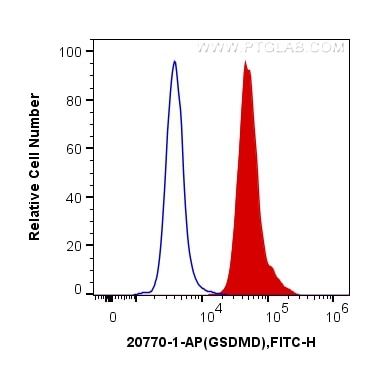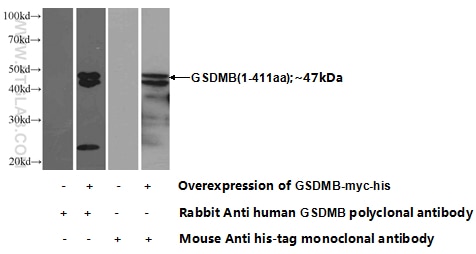- Phare
- Validé par KD/KO
Anticorps Polyclonal de lapin anti-GSDMD
GSDMD Polyclonal Antibody for WB, IF/ICC, FC (Intra), IP, ELISA
Hôte / Isotype
Lapin / IgG
Réactivité testée
Humain, rat, souris et plus (3)
Applications
WB, IHC, IF/ICC, FC (Intra), IP, ELISA
Conjugaison
Non conjugué
228
N° de cat : 20770-1-AP
Synonymes
Galerie de données de validation
Applications testées
| Résultats positifs en WB | cellules A431, cellules C6, cellules Jurkat, cellules NIH/3T3, tissu cérébral de rat, tissu hépatique de rat |
| Résultats positifs en IP | cellules THP-1, |
| Résultats positifs en IF/ICC | cellules HeLa, |
| Résultats positifs en FC (Intra) | cellules Jurkat, |
Dilution recommandée
| Application | Dilution |
|---|---|
| Western Blot (WB) | WB : 1:2000-1:10000 |
| Immunoprécipitation (IP) | IP : 0.5-4.0 ug for 1.0-3.0 mg of total protein lysate |
| Immunofluorescence (IF)/ICC | IF/ICC : 1:50-1:500 |
| Flow Cytometry (FC) (INTRA) | FC (INTRA) : 0.20 ug per 10^6 cells in a 100 µl suspension |
| It is recommended that this reagent should be titrated in each testing system to obtain optimal results. | |
| Sample-dependent, check data in validation data gallery | |
Applications publiées
| KD/KO | See 6 publications below |
| WB | See 184 publications below |
| IHC | See 47 publications below |
| IF | See 56 publications below |
| FC | See 1 publications below |
Informations sur le produit
20770-1-AP cible GSDMD dans les applications de WB, IHC, IF/ICC, FC (Intra), IP, ELISA et montre une réactivité avec des échantillons Humain, rat, souris
| Réactivité | Humain, rat, souris |
| Réactivité citée | rat, bovin, Humain, porc, souris, Hamster |
| Hôte / Isotype | Lapin / IgG |
| Clonalité | Polyclonal |
| Type | Anticorps |
| Immunogène | GSDMD Protéine recombinante Ag14757 |
| Nom complet | gasdermin D |
| Masse moléculaire calculée | 484 aa, 53 kDa |
| Poids moléculaire observé | 50-53 kDa |
| Numéro d’acquisition GenBank | BC008904 |
| Symbole du gène | GSDMD |
| Identification du gène (NCBI) | 79792 |
| Conjugaison | Non conjugué |
| Forme | Liquide |
| Méthode de purification | Purification par affinité contre l'antigène |
| Tampon de stockage | PBS avec azoture de sodium à 0,02 % et glycérol à 50 % pH 7,3 |
| Conditions de stockage | Stocker à -20°C. Stable pendant un an après l'expédition. L'aliquotage n'est pas nécessaire pour le stockage à -20oC Les 20ul contiennent 0,1% de BSA. |
Informations générales
GSDMD is a member of the gasdermin family. Members of this family appear to play a role in regulation of epithelial proliferation. GSDMD has been suggested to act as a tumor suppressor. Recently, GSDMD is identified as a new component of inflammasomes, and it is an executor of pyroptosis and required for interleukin-1β secretion. Cleavage of GSDMD by inflammatory caspases determines pyroptotic cell death.
Protocole
| Product Specific Protocols | |
|---|---|
| WB protocol for GSDMD antibody 20770-1-AP | Download protocol |
| IF protocol for GSDMD antibody 20770-1-AP | Download protocol |
| IP protocol for GSDMD antibody 20770-1-AP | Download protocol |
| Standard Protocols | |
|---|---|
| Click here to view our Standard Protocols |
Publications
| Species | Application | Title |
|---|---|---|
Nature Inflammasome-activated gasdermin D causes pyroptosis by forming membrane pores.
| ||
ACS Nano Engineering Extracellular Vesicles Restore the Impaired Cellular Uptake and Attenuate Intervertebral Disc Degeneration. | ||
Acta Pharm Sin B Miltirone induces cell death in hepatocellular carcinoma cell through GSDME-dependent pyroptosis. | ||
Acta Pharm Sin B A high-throughput Gaussia luciferase reporter assay for screening potential gasdermin E activators against pancreatic cancer | ||
Cell Res Gasdermin D is an executor of pyroptosis and required for interleukin-1β secretion. | ||
J Exp Med Protein kinase D at the Golgi controls NLRP3 inflammasome activation.
|
Avis
The reviews below have been submitted by verified Proteintech customers who received an incentive forproviding their feedback.
FH Isha (Verified Customer) (03-02-2021) | Bands were so clear. Could not refrain myself from writing this review.
|
